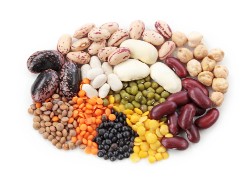Scientific Review of the FODMAP Diet for Gut Health
Food is the most common trigger of gastrointestinal symptoms. The restriction of individual products can significantly alleviate the general condition of people with many diseases of the gastrointestinal tract.
For example, a decrease in the diet of fermentable carbohydrates (FODMAP) has a beneficial effect on the course of irritable bowel syndrome (IBS).
Australian scientists have even developed a special FODMAP diet – a nutrition system with a low content of FODMAP substances.
Content
What is a Fodmap?

FODMAP substances is a concept that combines short–chain carbohydrates that are not digested in the digestive tract and are not absorbed by the human body.
FODMAP is an abbreviation for the following fermentable carbohydrates:
- Oligosaccharides : Wheat, rye, legumes, various vegetables such as onions and garlic.
- Disaccharides : Milk, cream cheese, yogurt. Lactose is the main carbohydrate.
- Monosaccharides : Various fruits including dates, figs, mangoes, agave, and honey. Fructose is the main carbohydrate.
- Polyols : Some fruits and vegetables such as blackberries, lychees, as well as some low-calorie sweets such as sugar-free chewing gums.
These substances contribute to an increase in the fluid content in the lumen of the digestive tube and increased gas formation. As a result, there is a pathological stretching of the intestinal wall, leading to a wide range of unpleasant symptoms: stool disorders such as constipation or diarrhea, bloating and soreness in the lower abdomen.
FODMAP diet was developed by Australian scientists to improve the condition of patients suffering from irritable bowel syndrome ( data is available regarding efficacy also in Crohn's disease).
The low-FODMAP nutrition system assumes the exclusion or maximum reduction of the described substances in the diet of patients. As a result, there is a decrease in symptoms and an improvement in the quality of life.
The benefits of such a diet
A diet with low levels of FODMAP substances has been tested on several tens of thousands of people in more than 30 scientific studies. The positive effects described below have an evidence base.
1. Reduction of dyspeptic disorders
 Disorders in individuals suffering from irritable bowel syndrome can vary widely. They include: increased gas formation, diarrhea or constipation, pain in the lower abdomen (usually worse at night or before the act of defecation).
Disorders in individuals suffering from irritable bowel syndrome can vary widely. They include: increased gas formation, diarrhea or constipation, pain in the lower abdomen (usually worse at night or before the act of defecation).
According to scientists, the distinctive unpleasant subjective symptoms are pain and bloating, which affect more than 80% of patients.
American scientists installed that these symptoms dramatically change the quality of life, depressing mood . 90% of respondents claim that they are ready to shorten their lives by a quarter in exchange for the opportunity to become healthy again. About 18% of patients take narcotic analgesics in order to relieve pain.
Exclusion of FODMAP products from the diet has a beneficial effect on the general condition of patients. According to one of the major foreign meta-analyses, when observing a diet with low FODMAP, there is a decrease in the severity of abdominal pain and increased gas formation, mood is normalized and brain function .
How claim British experts, such a diet option also allows you to effectively combat constipation or diarrhea.
2. Improving the quality of life
 People suffering from irritable bowel syndrome experience significant restrictions on habitual activity, some lose not only their work and social adaptation, but also their ability to self–serve.
People suffering from irritable bowel syndrome experience significant restrictions on habitual activity, some lose not only their work and social adaptation, but also their ability to self–serve.
According to the data Australian scientists, the Fodmap diet leads to a decrease in the severity of the main symptoms of the disease. The study was based on a questionnaire of patients on the scales of severity of symptoms of irritable bowel syndrome (IBS-SSS and IBQ-QOL).
To whom is it shown?
 The diet is indicated mainly for people who suffer from irritable bowel syndrome.
The diet is indicated mainly for people who suffer from irritable bowel syndrome.
The most important thing to do before prescribing a diet is to make sure that the diagnosis is correct (confirmed by laboratory and instrumental means), exclude all possible other pathologies with a similar clinical picture.
In addition to IBS, it is possible to use a diet for the following conditions:
- Crohn's disease.
- Nonspecific ulcerative colitis.
- Celiac disease.
- Endometriosis.
- Fibromyalgia.
- Functional dyspepsia.
- Scleroderma.
- Diverticulitis.
- Chronic fatigue syndrome.
However, evidence regarding the effectiveness of the diet in written pathologies is almost completely absent. Therefore, a change in diet cannot be recommended.
Before starting treatment, it is extremely important to enlist the support of a specialist. Only a doctor can correctly assess the state of health and make the right decision.
How to follow correctly – 3 steps
The FODMAP protocol is a complex power supply system. A full-fledged transition includes several stages that must be followed.
Stage 1: Restriction
 At the heart of this stage is a strict restriction on the consumption of any foods with a high FODMAP.
At the heart of this stage is a strict restriction on the consumption of any foods with a high FODMAP.
The maximum duration of the first stage is 3-8 weeks. Do not stay at this stage any longer.
Thoughtlessly excluding all FODMAP products for a long time will lead to the fact that the body will receive less important Probiotics and prebiotics , which will lead to dysbiosis.
Stage 2: Food Provocation
At this stage, foods with high levels of FODMAP are being added to the diet one at a time. The objectives of such an experiment are:
- Determination of the individual sensitivity of the body to various groups of FODMAP products.
- Setting the maximum "threshold" level of FODMAP substances that a person can consume per day.
Specialists advise add one "new" product to the diet, consume it for 2-3 days and monitor the body's reaction. Even if the body reacts to the product normally, you still exclude it after 2-3 days and add the next one to the diet.
The total duration of the entire stage is no more than 1.5 months.
Stage 3: Personalization
So, in the second stage, you have identified which fodmap products you tolerate well and which are bad.
At the third and final stage, it is necessary to return to the diet as many foods with a high content of FODMAP as possible, to which good tolerance has been noted. At the same time, it is necessary to monitor the severity of the symptoms of the underlying disease (they should not increase).
At the third stage, it is necessary to observe the maximum possible variety (periodically include even poorly tolerated foods in small quantities in the diet). All this is like claim foreign experts, will improve intestinal health and quality of life in the long term.
This final phase is also called the "personalized" or "modified" Fodmap diet, since it is individual for each person. Only such an individual diet can be followed for a long time.
FODMAP content in products (Table)
The table below shows various foods with low and high FODMAP content.
| Product Group | Lowest FODMAP content | Highest FODMAP content. |
| Fruits | Bananas, blueberries, grapefruits, lemons, limes, tangerines, oranges, raspberries, rhubarb. | Apples, watermelons, apricots, pears (Chinese), plums, peaches, persimmons. |
| Vegetables | Carrots, chili peppers, ginger, eggplant, cucumbers, potatoes, tomatoes, spinach, beans. | Garlic, onion, asparagus, cauliflower, green onion, mushrooms. |
| Protein Sources | Meat – chicken, beef, pork, veal. Eggs. Nuts –almonds, peanuts, pecans, macadamia, pine nuts and walnuts. | Legumes, |
| Cereals and bakery products | Buckwheat, corn, oats, millet, brown rice. | Rye, barley, wheat. |
| Lactic acid products | Cheddar cheese and parmesan, lactose-free milk , rice milk. | Condensed or concentrated milk, plain milk, cream cheese, yoghurts. |
Sample menu for the week
Based on the list of low-FODMAP foods, there are many recipes for dishes. Below is an example of a 7-day menu.
| Day 1 | |
| Breakfast | Omelet with grated cheddar or parmesan cheese. Salad based on cucumbers, lettuce leaves and tomatoes. 2 bread toasts. 200 ml of coffee. |
| Lunch | Sandwich with gluten-free bread, chicken meat and a slice of hard cheese. 200 ml of green tea. |
| Afternoon tea | Sunflower seeds or corn chips. |
| Dinner | Baked potatoes. Lettuce and tomato salad with balsamic vinegar. 200 ml of tea (black or green with mint). |
| Day 2 | |
| Breakfast | Smoothies based on banana, frozen strawberries, almond milk and flax seeds. 200 ml of green tea. |
| Lunch | Sandwich with bread (gluten-free), cheddar cheese, turkey, mayonnaise. 200 ml of tea. |
| Afternoon tea | 200-300 g. melons, crackers. |
| Dinner | Chicken baked in the oven with green onions, sunflower oil, pepper. Brown rice, steamed green beans. |
| Day 3 | |
| Breakfast | Oatmeal porridge with blueberries and brown sugar. 200 ml of coffee. |
| Lunch | Oven-baked chicken, tomato salad and spinach leaves. Vinaigrette. |
| Afternoon tea | Sunflower seeds. Crackers. |
| Dinner | Turkey salad with cabbage, grated carrots and green beans. Green tea with mint. |
| Day 4 | |
| Breakfast | Oatmeal porridge with prunes. 2 bread toasts (gluten-free and lactose-free). 200 ml of coffee. |
| Lunch | Sandwich with gluten-free bread, chicken meat and a slice of hard cheese. 200 ml of green tea. |
| Afternoon tea | Gluten-free cracker. Strawberry berries. |
| Dinner | Baked potatoes. Salad of fresh herbs and tomatoes with balsamic vinegar. 200 ml of tea (black or green with mint). |
| Day 5 | |
| Breakfast | Oatmeal porridge with banana slices and brown sugar. |
| Lunch | Sandwich with gluten-free bread, turkey meat, mustard and a slice of cheese. 200 ml of green tea. |
| Afternoon tea | Melon. |
| Dinner | Stewed chicken with vegetables. 2 apples. 200 ml of any tea with mint. |
| Day 6 | |
| Breakfast | Smoothies based on banana, frozen strawberries, almond milk and flax seeds. 200 ml of coffee. |
| Lunch | Sandwich with bread (bakery product should not contain lactose and gluten), cheddar or parmesan cheese, turkey, mayonnaise. 200 ml of tea. |
| Afternoon tea | 200-300 g. melons, crackers. |
| Dinner | Chicken baked in the oven with green onions, sunflower oil, bell pepper. Brown rice, steamed green beans. |
| Day 7 | |
| Breakfast | Oatmeal porridge with prunes. 2 bread toasts (the bakery product should not contain lactose and gluten). 200 ml of coffee. |
| Lunch | Sandwich with gluten-free bread, chicken meat and hard cheese. 200 ml of green tea. |
| Afternoon tea | Gluten-free cracker. Strawberry berries. |
| Dinner | Baked potatoes. Cucumber salad with tomatoes with the addition of sunflower oil. 200 ml of tea (black or green with mint). |
Conclusion
A low FODMAP diet is extremely beneficial for people suffering from irritable bowel syndrome. Although all patients have an individual reaction to the diet, in most cases there is a decrease in the severity of abdominal pain, flatulence, and an improvement in the quality of life in general.
Switching to a similar diet is a complex, multi–step task that is recommended to be carried out together with the attending physician.